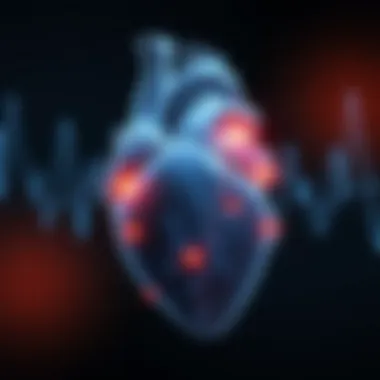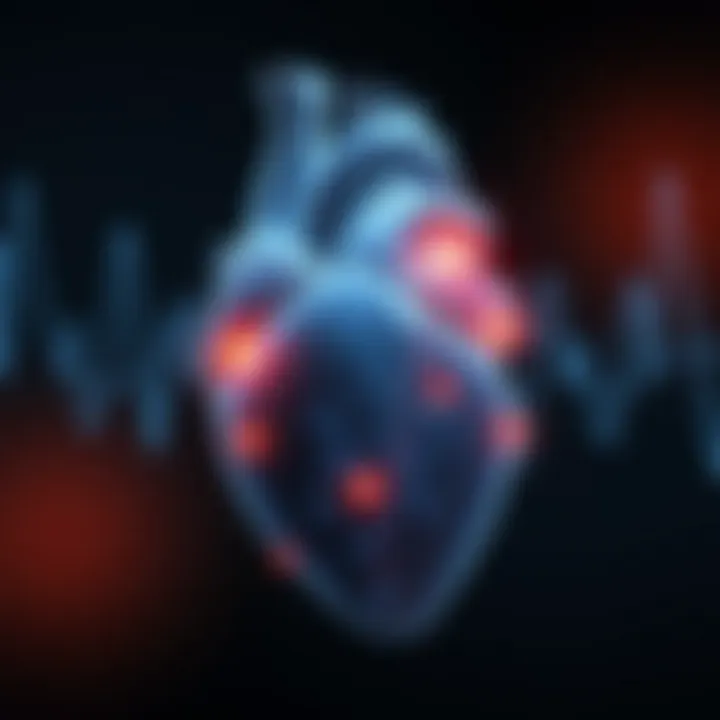Detecting Irregular Heartbeats: A Complete Guide


Intro
Detecting irregular heartbeats, also known as arrhythmias, is a critical aspect of cardiovascular healthcare. Understanding how to spot these anomalies can make a significant difference, especially considering their potential to lead to serious health issues. This guide is an exploration of methodologies, technologies, and essential clinical considerations that surround the detection of arrhythmias.
Many may wonder why such a seemingly simple rhythmic pulsing can turn into a chaotic event. In fact, irregular heartbeats can range from benign palpitations to life-threatening conditions. Therefore, delineating between them is pivotal for effective treatment and management. This article will help elucidate these complex concepts, integrating insights from current research and clinical practices.
Throughout the examination of various detection methods, underlying causes, and the symptoms tied to these irregularities, readers will uncover the landscape of arrhythmia detection.
Additionally, understanding the implications of such conditions on overall health is crucial. Early recognition of these issues can lead to timely intervention and potentially save lives. With that in mind, readers can expect a detailed discussion that delves into both the technical tools used in diagnosis and the human factors that contribute to effective monitoring of heart health.
Prelims to Irregular Heartbeats
The world of cardiac health is vast and often complex, yet understanding irregular heartbeats holds significant merit. Arrhythmias, the medical term for irregular heartbeats, can serve as the first red flag signaling potential heart-related issues. The pivotal role of this topic lies not only in the identification of such irregularities but also in comprehending their implications and finding effective management strategies.
Irregular heartbeats can range from a minor nuisance to a serious risk factor for severe health issues, like stroke or heart failure. Therefore, recognizing the nuances of these conditions can enhance preventive measures and guide timely interventions.
Understanding Heart Rhythms
The heart functions akin to a meticulous orchestral conductor, maintaining a steady rhythm to ensure every cell in the body receives its share of oxygen-rich blood. The normal heartbeat has a range between 60 to 100 beats per minute, influenced by several factors, including fitness levels, stress, and overall health. In more technical terms, the heartbeat is regulated by electrical impulses originating from the sinoatrial (SA) node, the heart's natural pacemaker.
When these impulses are disrupted, the rhythm can become erratic, leading to conditions such as atrial fibrillation or bradycardia. Such rhythm disturbances can feel like a sledgehammer in the chest or a mere fluttering, depending on the underlying cause.
Recognizing these rhythms, or lack thereof, can help in effective monitoring and satisfactory management of one's heart health. The body has its own signals; sometimes they whisper softly, and at other times they ring alarm bells.
Common Types of Irregular Heartbeats
There are several types of irregular heartbeats, each with its own set of causes and considerations. Some of the most widely known include:
- Atrial Fibrillation: Often described as chaotic and fast, this type can lead to clotting and may require immediate medical attention.
- Atrial Flutter: Similar to atrial fibrillation but usually more organized in its impact, leading to a rapid heartbeat.
- Ventricular Tachycardia: A rapidly beating heart that originates in the ventricles; it can lead to sudden cardiac arrest.
- Bradycardia: A slower than normal heartbeat, potentially leading to dizziness or fainting.
The significance of distinguishing among these types cannot be overstated. Different types define the course of action that healthcare professionals might take. Therefore, adequate education and awareness of these heart rhythms is paramount for both patients and healthcare practitioners alike.
Understanding irregular heartbeats not only emphasizes the importance of monitoring heart health but also serves as a catalyst for further intervention when necessary. And as is often said, an ounce of prevention is worth a pound of cure.
Physiology of Heartbeats
Understanding the physiology of heartbeats lays the foundation for grasping the mechanisms behind irregular heart rhythms. The heart is not just a muscular organ that pumps blood; it operates using a sophisticated electrical system that orchestrates every beat. This system ensures that oxygen-rich blood reaches all parts of the body efficiently. Thus, understanding its workings is essential for recognizing disruptions that may lead to an arrhythmia.
Role of the Heart's Electrical System
At the core of the heart's function lies its electrical system, responsible for initiating and regulating the heartbeat. The journey begins in the sinoatrial (SA) node, often referred to as the heart's natural pacemaker. This small cluster of cells sets the rhythm by sending out electrical impulses that cause the heart muscles to contract.
- Generation of Impulses: The SA node generates action potentials at a rate of 60 to 100 times per minute under normal conditions. If you picture it like a conductor leading an orchestra, the SA node dictates the tempo of heart contractions, ensuring a smooth flow of blood through the heart chambers.
- Propagation Through the Heart: After the SA node fires, the impulses travel to the atrioventricular (AV) node and then to the bundle of His. This sequence allows for a slight delay, letting the atria empty completely before the ventricles contract.
- Coordinated Contractions: This electrical pathway cascades through the cardiac muscle fibers, resulting in coordinated contractions. When this system falters, however, it can lead to irregular heartbeats or arrhythmias. Understanding this process not only demystifies heart function but is imperative when diagnosing conditions that affect heart rhythm.
Factors Influencing Heart Rate
Various factors influence heart rate, shaping how quickly or slowly the heart beats. Recognizing these can help identify potential issues that might prompt further investigation. Here are a few key elements:
- Age: As individuals age, the heart's electrical system may undergo changes, affecting overall heart rate.
- Fitness Level: Regular physical activity is known to lower resting heart rate. A well-conditioned heart pumps more efficiently, needing fewer beats per minute.
- Stress and Emotions: Emotional states can dramatically influence heart rate. Stress releases hormones like adrenaline, which can speed up the heart's rhythm.
- Medications: Certain medications can either increase or decrease heart rate. For instance, beta-blockers are often prescribed to manage high heart rates by slowing them down.
- Body Temperature: Elevated body temperature increases metabolism and, subsequently, heart rate.
Being attentive to these factors not only aids in understanding individual heart health but also shines a light on when something may be off. Monitoring these aspects can prove invaluable in the early detection of irregular heartbeats.
"The heart's rhythm is not just a medical detail; it reflects the intricate dance of life coursing through our veins."
Identifying Symptoms of Irregular Heartbeats
Understanding irregular heartbeats, or arrhythmias, is crucial for maintaining cardiovascular health. Irregularities in heart rhythm can often go unnoticed, which is why identifying their symptoms is an essential step for early detection and management. This section delves into the common symptoms experienced by individuals with irregular heartbeats and highlights when someone should seek medical advice. By recognizing these indicators, patients can make informed decisions about their health, possibly preventing more severe complications down the line.
Common Symptoms Experienced
Arrhythmias can present a variety of symptoms, and not every individual experiences them in the same manner. Some may feel like their heart is skipping a beat, while others might describe a more fluttering sensation in their chest. Here are several common symptoms associated with irregular heartbeats:
- Palpitations: Many individuals report a rapid or pounding heart, often experienced during rest or light activity.
- Dizziness or Lightheadedness: An irregular heartbeat can affect blood flow to the brain, resulting in feelings of faintness or unsteadiness.
- Shortness of Breath: Difficulty in breathing or feeling winded during everyday tasks can be a warning sign of an underlying issue.
- Chest Pain: Some people with arrhythmias might experience discomfort or pressure in the chest area, which should not be ignored.
- Fatigue: A sense of unusual tiredness can occur as the heart struggles to pump blood efficiently.
It’s essential to note these symptoms can vary widely; not everyone may notice drastic signs.


"Recognizing the early signs is half the battle. Be proactive with your heart."
When to Seek Medical Advice
While occasional palpitations are typically harmless, there are certain situations where seeking medical advice becomes imperative. It’s wise to err on the side of caution when experiencing any of the following:
- Persistent Symptoms: If palpitations or other symptoms are persistent or worsening over time.
- Associated Symptoms: Experiencing symptoms like chest pain, extreme shortness of breath, or fainting alongside irregular beats.
- Family History: If there are known heart issues in your family, it would be prudent to consult a healthcare provider.
- New Symptoms After Age 40: As age increases, the likelihood of serious heart conditions grows. Any new symptoms should be evaluated.
- Healthy Lifestyle Change: If a previously healthy person experiences unexpected symptoms after significant lifestyle changes, this can be a red flag.
Ultimately, it is important to maintain an open dialogue with healthcare professionals. Regular check-ups can help catch issues before they escalate, and being proactive about heart health is vital.
Diagnostic Tools for Detection
Diagnosing irregular heartbeats, or arrhythmias, is a multi-step process that relies on several sophisticated tools to ensure accurate detection and treatment. With the right diagnostic equipment, healthcare professionals can unveil valuable insights into a patient’s heart health. These tools are pivotal not just in identifying existing arrhythmias, but also in monitoring potential future risks. The realm of diagnostic tools encompasses a variety of methodologies, each tailored to capture distinct aspects of the heart's function. In this section, we will delve into several critical tools, recognizing their significance in comprehensive cardiac assessment.
Electrocardiograms (ECGs)
One of the cornerstone methods for heart rhythm evaluation is the Electrocardiogram, commonly referred to as an ECG or EKG. This test is widely utilized due to its ability to record the electrical activity of the heart over a period, providing a graph that shows every heartbeat.
When a clinician performs an ECG, they place electrodes on the patient's skin, usually on the chest, arms, and legs. The electrodes measure the electrical signals produced by the heart as it beats. The results can uncover a plethora of information, including:
- Heart rate and rhythm
- The presence of any irregular heartbeats
- Evidence of a previous heart attack
- Structural issues impacting heart function
ECGs help in quickly diagnosing conditions such as atrial fibrillation and ventricular tachycardia. Moreover, being a relatively quick test—often taking only a matter of minutes—it's a highly effective first step for anyone experiencing symptoms like palpitations or dizziness. Thus, an ECG can be seen as a well-regarded avenue for early detection and treatment intervention.
Holter Monitoring
While an ECG provides a snapshot of heart activity, Holter monitoring digs deeper by capturing continuous data for a longer duration, usually 24 hours or more. This type of ECG is portable and worn by the patient as they go about their daily routines. The process generally involves wearing a small device connected to electrodes on the skin, allowing for ongoing assessment.
The primary advantage of Holter monitoring is its ability to catch irregularities that may not show up during a standard ECG due to factors like stress or specific activities. It is particularly beneficial for patients who experience intermittent symptoms, enabling doctors to correlate the experiences with recorded data. Here are a few essential points about Holter monitors:
- Extended observation: Unlike a standard ECG, Holter monitoring covers a comprehensive period, increasing the likelihood of detecting abnormalities.
- Patient engagement: Being mobile, the patient can record events in a diary, noting symptoms that occur during the monitoring, which adds context to the readings.
Holter monitoring provides a deeper understanding of how heart arrhythmias might behave over time, leading to more tailored and effective treatment.
Event Recorders
Event recorders are another piece of the puzzle in the diagnostic toolkit for irregular heartbeats. These devices are similar to Holter monitors but are typically used over a longer duration (up to several weeks). They are often ideal for individuals who experience symptoms less frequently than what Holter monitoring could catch.
Patients wear a small device or carry it with them, activating it when they notice symptoms like an unusual heartbeat or chest discomfort. The data is then sent to a healthcare provider for analysis. This method comes with its own set of advantages:
- On-demand recording: Patients can activate the device when they feel symptoms, ensuring that the recorded activity is relevant.
- Long-term tracking: Some advanced devices can store up to 30 days' worth of data, which is beneficial for assessing transient issues.
In essence, event recorders serve to fill the gaps by ensuring that potential problems, which could allude standard testing, are brought to light. They help reinforce a patient's narrative of their symptoms with actual data, offering invaluable insights to healthcare providers.
Diagnostic tools are not merely gadgets; they are the keys that unlock the mystery surrounding heart health. A focused approach in using these tools is essential for effective treatment and management.
In summary, the variety of diagnostic tools at our disposal—from the quick ECG to the thorough Holter monitoring and the patient-activated event recorders—provides a robust framework for understanding, diagnosing, and managing irregular heartbeats. Each method complements the others, ensuring that individuals receive precise care and monitoring tailored to their unique heart health needs.
Relevant resources for further reading include Mayo Clinic], American Heart Association, and detailed patient guides on MedlinePlus.
Advanced Technologies in Detection
In the realm of cardiology, the landscape is shifting rapidly, with advanced technologies emerging that offer significant improvements in the detection of irregular heartbeats. These technologies not only enhance the accuracy of diagnosis but also facilitate ongoing monitoring—allowing health professionals and patients alike to be proactive in managing heart health. The rise of innovation in this area highlights its importance in preventing serious cardiovascular conditions and underscores the need for education regarding their application.
Wearable Monitoring Devices
Wearable monitoring devices have taken the health tech world by storm. Devices like the Apple Watch and Fitbit have enabled individuals to keep a close eye on their heart rate and rhythm. These gadgets are designed to be worn on the wrist, which makes them convenient and easy to use in everyday life.
One significant advantage of these devices is their ability to collect data continuously. Most heart rhythm irregularities occur sporadically, meaning that traditional methods like a single ECG in a clinic may miss critical insights. With continuous monitoring, users often receive real-time alerts when their heart rate deviates from their normal range, prompting immediate action when necessary. Some of these devices also provide detailed analytics that can be shared with healthcare providers, creating a comprehensive picture of one's heart health over time.
Highly regarded for their accessibility, wearable devices engage the user in their health journey. For instance, a user might receive a notification about an which can lead them to schedule a check-up with their doctor for further investigation. However, it’s crucial to remember that while wearables are fantastic tools for monitoring, they should not replace professional medical evaluations.
Smartphone Applications
Smartphone applications represent another leap forward in the quest to monitor heart health. Solutions like AliveCor’s Kardia and Qardio can turn a mobile device into a personal health monitor, allowing users to conduct an ECG test with unparalleled convenience. These apps typically work with compatible sensors, creating an easy interface to capture heart rhythm data at any time.
The major benefit of smartphone apps is the ease of use combined with accessibility. Users can record their heart rate anytime, anywhere, and the data can be analyzed instantly, often delivering results in under a minute. This capability makes it possible for patients to detect irregularities and seek medical advice early—potentially averting serious complications. Furthermore, many of these applications allow for seamless sharing with healthcare professionals, ensuring that medical personnel have the most up-to-date information.


However, there are considerations for users to be aware of. The reliability of these applications can vary greatly, and they often lack the depth of analysis that a healthcare professional provides during a comprehensive examination. Individuals should consult with their doctors to determine when to rely on these technologies and how to interpret any readings they may generate.
In summary, these advanced technologies—wearable devices and smartphone applications—are revolutionizing the way we detect and monitor irregular heartbeats. They provide real-time data, empower individuals in managing their health, and foster proactive healthcare engagement.
For further information on heart health technologies, you might find these resources useful:
- Wikipedia on Heart Monitoring Technologies
- Britannica on Heart Rate
- Reddit's Health Technology Community
- Health.gov for Cardiovascular Health
- NIH on Cardiology Advances
Understanding the Causes of Irregular Heartbeats
Understanding the underlying causes of irregular heartbeats is paramount for grasping the complexities associated with this condition. Irregular heartbeats, or arrhythmias, can arise from a myriad of factors, which can range from genetic predispositions to environmental influences and existing medical conditions. By comprehensively networking these causes, one can better appreciate their implications on cardiovascular health.
Through careful analysis, it becomes clear that being informed about these origins can empower individuals to take proactive measures to maintain heart health. Recognizing risk factors allows for timely interventions, potentially mitigating severe complications such as strokes or heart attacks. Furthermore, understanding these causes can aid healthcare professionals in tailoring appropriate treatment options.
A well-rounded exploration of these elements not only enhances the reader's awareness but also nurtures a proactive approach to cardiovascular care.
Genetic Factors
Genetic influences on heart rhythm abnormalities can play a pivotal role. Families often share a history of heart conditions, signaling that certain arrhythmias can be inherited. For instance, Long QT Syndrome or Brugada Syndrome may stem from genetic mutations affecting the heart’s electrical system. Understanding these inherited traits can shape a person's preventive strategies.
It's important to consider that a history of heart issues in the family might necessitate more vigilant monitoring. Genetic testing may also be beneficial in identifying individuals who are at risk, providing them with tailored advice about lifestyle and medical interventions.
Lifestyle Influences
Lifestyle choices wield significant sway over heart health. Factors such as smoking, excessive alcohol consumption, sedentary behavior, and poor diet can exacerbate the likelihood of developing arrhythmias. High caffeine intake, stress levels, and even sleep patterns can also disturb heart rhythm.
To illustrate, regular physical activity can bolster heart health, whereas prolonged inactivity could invite problems. Likewise, managing stress through relaxation techniques or mindfulness practices often serves to stabilize one’s heart rate.
Here's a short list of lifestyle adjustments that could enhance heart rhythm:
- Balanced Diet: Incorporate fruits, vegetables, whole grains, and lean proteins.
- Regular Exercise: Engage in at least 150 minutes of moderate activities weekly.
- Stress Management: Use meditation or yoga as tools to diminish stress.
Medical Conditions Related to Arrhythmia
Numerous medical conditions can lead to irregular heartbeats. Diseases like hypertension, diabetes, or hyperthyroidism are often contributors. Moreover, structural heart issues, such as those resulting from previous myocardial infarction, can impede normal electrical functioning.
Understanding your current health status is essential for recognizing the potential for developing arrhythmias. Regular check-ups can reveal hidden issues that may necessitate intervention. Conditions like obstructive sleep apnea also warrant attention, as they can lead to disrupted heart rhythms during episodes of apnea.
"Awareness is the first step toward health. Understanding your body can empower you to change it."
For further reading on heart health, consider visiting the American Heart Association's resource page at heart.org and exploring insights on genetics from the National Institutes of Health at nih.gov.
By being proactive about understanding these causes and their relationships with heart rhythm, individuals can better arm themselves with the tools necessary to navigate their heart health.
The Importance of Monitoring Heart Health
Monitoring heart health is paramount in understanding and managing irregular heartbeats, also known as arrhythmias. Regular check-ups not only help in early detection but also aid in managing existing conditions effectively. It is like keeping an eye on a garden; if you don’t water the plants regularly, they may wilt or worse, die. Hence, being proactive about heart health can lead to substantial long-term benefits.
Impact on Overall Health
An irregular heartbeat can have broader implications beyond just feeling a thump or missed beat. This is where the significance of monitoring comes into play. For instance:
- Increased Risk of Stroke: Heart arrhythmias can lead to blood clots, particularly in conditions such as atrial fibrillation. If a clot travels to the brain, it can cause a stroke, which may drastically affect one’s life.
- Potential Heart Failure: Over time, an irregular heartbeat can weaken the heart's efficiency. Monitoring enables healthcare providers to track this decline before it escalates.
- Complications in Existing Medical Conditions: For individuals with diabetes, high blood pressure, or other chronic conditions, abnormal heart rhythms can complicate their management, increasing morbidity.
Regular assessments create a safety net, providing insights into your heart's functioning and flagging any concerning changes early on. This can be a major game changer in avoiding catastrophic health events.
Preventive Measures
When it comes to heart health, an ounce of prevention is worth a pound of cure. Being smart about lifestyle choices can help stave off issues before they pop up. Here are some effective preventive measures to consider:
- Regular Health Screenings: Get your blood pressure, cholesterol, and blood sugar levels checked routinely. These factors can shape your risk levels significantly.
- Heart-Healthy Diet: Consuming a diet low in saturated fats and high in fruits, vegetables, and whole grains fosters a strong cardiovascular system. It's not just about weight, it's about nurturing your body.
- Physical Activity: Engaging in at least 150 minutes of moderate exercise weekly is advisable. This is the norm, but those with existing health conditions should follow tailored exercise plans set forth by medical professionals.
- Limit Alcohol and Quit Smoking: While many enjoy a drink, excessive consumption can lead to irregular heart rhythms. Smoking, on the other hand, is a known enemy to heart health.
- Stress Management: High stress can lead to increased heart rate and stress hormones that influence heart rhythms. Techniques like yoga or deep breathing can offer substantial benefits.
Monitoring heart health provides the foundation for adopting these preventive measures. Knowledge is power. When individuals are aware of their heart’s condition, they are more likely to make informed lifestyle choices that may benefit their overall well-being.
As you move forward into daily routines, remember that keeping a finger on the pulse of your heart health is a wise investment for both present and future happiness. Awareness leads to action, and action can lead to a healthier life.
Intervention Strategies for Irregular Heartbeats


Addressing irregular heartbeats is fundamentally crucial for maintaining cardiovascular health. The strategies employed to intervene can significantly affect the quality of life for those impacted. Without appropriate measures, irregular heartbeats, also known as arrhythmias, can lead to complications like stroke or heart failure. The journey towards managing these conditions encompasses a blend of lifestyle changes, medications, and sometimes surgical options. Understanding the nuances of these intervention strategies empowers patients and physicians alike to tailor treatment plans to individual needs.
Lifestyle Modifications
Lifestyle changes can serve as the first line of defense against irregular heartbeats. Making conscious choices in daily life can often lead to substantial improvements. Here are some key modifications to contemplate:
- Dietary Adjustments: Consuming a heart-healthy diet, rich in fruits, vegetables, and whole grains, plays a critical role. Limiting saturated fats, sugars, and salt can also support heart health. For instance, incorporating potassium-rich foods like bananas or spinach can help stabilize heartbeat regularity.
- Regular Exercise: Physical activity strengthens the heart and improves overall cardiovascular function. Engaging in moderate exercise, such as brisk walking or swimming, for about 150 minutes a week might enhance heart health significantly. A personal trainer can help tailor a regimen that suits one's health status.
- Stress Management: High stress levels often exacerbate arrhythmias. Practices such as yoga, meditation, or even hobbies that incite joy can mitigate stress. Finding an outlet for stress might just be what the heart needs to find its rhythm again.
- Avoiding Stimulants: Substances like caffeine and nicotine can trigger or worsen irregular heartbeats. Reducing or eliminating these stimulants can lead to better heart consistency.
These lifestyle modifications, though simple, lay the groundwork for managing irregular heartbeats.
Medication Options
In some instances, lifestyle adjustments alone may not suffice, and medications come into play. The complexity of arrhythmias necessitates a carefully considered pharmaceutical approach:
- Antiarrhythmic Drugs: Medications such as amiodarone or sotalol help to restore a normal rhythm. They act by altering the heart's electrical activity, ensuring that impulses travel correctly without disruption.
- Beta-Blockers: These drugs can lower heart rate and relieve symptoms of increased heart activity. They are particularly useful for managing palpitations and other related symptoms.
- Blood Thinners: For those at risk of stroke due to arrhythmias, anticoagulants like warfarin or newer alternatives like apixaban may be prescribed to prevent clot formation.
- Heart Rate Control Medications: Drugs like digoxin work by improving heart contractions and controlling the heart rate, specifically in rapid rhythms.
Regular consultations with healthcare providers are crucial to monitor the efficacy and adjust dosages of these medications as necessary.
Surgical Procedures and Ablation
While lifestyle and medication strategies are often effective, there are instances when surgical intervention becomes necessary. Here are some of the surgical routes healthcare professionals might explore:
- Catheter Ablation: This minimally invasive procedure destroys small areas of heart tissue that cause abnormal electrical signals. Using radiofrequency energy or cryotherapy, catheters are guided through blood vessels to the heart, paving the way for a more consistent rhythm.
- Pacemakers: When the heart needs help maintaining a regular rhythm, a pacemaker may be implanted. This small device sends electrical impulses to the heart, helping it beat at a consistently healthy rate.
- Implantable Cardioverter-Defibrillators (ICDs): For high-risk patients, an ICD can be life-saving. This device monitors the heart's rhythm and can deliver shocks to restore normal function during dangerous arrhythmias.
- Coronary Bypass Surgery: In cases where the heart’s vascular system contributes to arrhythmias, bypass surgery may be appropriate. This surgery improves blood flow to the heart muscle, alleviating symptoms.
In summary, intervention strategies for irregular heartbeats are multifaceted. A well-rounded approach that incorporates lifestyle modifications, medications, and, when necessary, surgical solutions can significantly impact patient outcomes and overall cardiovascular health. The collaboration between patients and healthcare professionals remains pivotal in navigating this complex landscape of heart health.
Role of Healthcare Professionals
The role of healthcare professionals in managing irregular heartbeats cannot be overstated. Their expertise creates the framework for effective diagnosis and ongoing care. From cardiologists to primary care physicians, these professionals ensure that every piece of a patient’s health puzzle fits perfectly together, enhancing the likelihood of positive treatment outcomes.
Healthcare professionals bring a wealth of knowledge about the heart and its various rhythms, which is crucial for identifying arrhythmias promptly. Since some irregular heartbeats might not show symptoms, trained practitioners are vital in recognizing subtle signs that could suggest a more significant problem lies beneath the surface. Their clinical skills lay the groundwork for comprehensive patient assessments, which can include EKG tests and prolonged monitoring, all essential for creating individualized care plans.
In addition, healthcare providers play a pivotal role in educating patients about their conditions. Many individuals are unaware of what constitutes an irregular heartbeat or the potential implications for their health. By explaining these complexities, providers empower patients to take charge of their health. This education doesn't end at the doctor's office; ongoing support through communication channels ensures that patients feel engaged and informed about their cardiovascular health. People tend to feel more secure when they understand the situation, which can lead to better adherence to treatment regimens.
A significant benefit of having a solid healthcare team is the multidisciplinary collaboration that often occurs. Cardiologists can work alongside primary care physicians, nurse practitioners, and even specialists like electrophysiologists, creating a network of care that leverages each professional's strengths. When patients encounter irregular heart issues, it’s sometimes necessary to consult multiple experts to identify the best strategies for treatment. Such collaboration ultimately provides a streamlined, effective response to cardiac concerns.
“Collaboration is key; when healthcare professionals work together, they ensure that no stone is left unturned in patient care.”
Collaboration in Patient Care
The collaboration between varied healthcare professionals guarantees that patients receive a holistic approach to their care. They share information and insights, thus strengthening the diagnostic process and treatment strategies. For instance, a cardiologist may identify a specific type of irregular heartbeat, and in collaboration with a registered nurse, they can then monitor the patient's response to various treatments effectively.
This collaborative framework often involves regular case discussions, where healthcare providers assess treatment outcomes and adjust strategies as needed. Such team dynamics can significantly enhance treatment efficacy, leading to lower rates of complications and hospital readmissions. Each member of the healthcare team brings something unique, whether it’s clinical expertise, patient advocacy, or practical wisdom gained from years of experience.
Furthermore, by maintaining lines of communication with each other, healthcare professionals can respond swiftly if a patient's condition worsens or if new symptoms arise. This ability to pivot and adapt ensures that patient care remains at the forefront, ultimately prioritizing patient longevity and quality of life.
Guidelines for Regular Check-Ups
Establishing guidelines for regular check-ups is essential to managing irregular heartbeats effectively. These appointments serve as important checkpoints along the patient’s healthcare journey. If patients have experienced irregular heartbeats, follow-up visits can detect changes early and assess how well the treatment is working.
Regular check-ups may include:
- Physical exams to monitor heart health and overall condition.
- ECGs to keep track of heart rhythm.
- Blood tests to check overall health and medication effects.
- Patient interviews to gauge symptoms and lifestyle changes.
Healthcare professionals often recommend that even those without symptoms keep up with regular visits, particularly if they have risk factors for cardiovascular disease, such as hypertension or diabetes. For patients under treatment for arrhythmias, these visits become even more critical, filtering vital data on the patient's response to medications or lifestyle changes.
Incorporating these routine check-ups into a patient’s life sets a foundation for continuity of care. It also demonstrates to patients that their health is a priority, fostering a stronger patient-provider relationship. By formulating and adhering to check-up guidelines, healthcare professionals help ensure that irregular heartbeats are managed securely and scientifically, underpinning the importance of vigilance in cardiovascular health.
End
The significance of understanding and addressing irregular heartbeats cannot be understated. This comprehensive guide serves as a pivotal resource for individuals seeking to navigate the complex realm of cardiovascular health. Recognizing the symptoms and potential risks associated with arrhythmias allows for timely intervention, which can lead to improved outcomes and enhanced quality of life. Every individual deserves the opportunity to be proactive about their heart health, and knowledge is a crucial first step in this journey.
Summary of Key Points
Throughout this article, several crucial points have emerged, including:
- Understanding Symptoms: Recognizing the telltale signs of irregular heartbeats, like palpitations or dizziness, is essential for early diagnosis.
- Diagnostic Methods: Utilization of tools such as Electrocardiograms and Holter Monitoring empowers both patients and healthcare providers to monitor heart health effectively.
- Lifestyle Impact: Acknowledging personal lifestyle choices, such as diet and exercise, can significantly influence heart health, both positively and negatively.
- Intervention Strategies: From lifestyle changes to medication and surgical options, a diverse array of interventions exists to manage symptoms effectively.
- Professional Guidance: Regular check-ups with healthcare professionals ensure that individuals remain informed and supported in managing their heart conditions.
Future Directions in Research and Awareness
Looking forward, it is evident that ongoing research is essential in the field of irregular heartbeats. As technology advances, newer methods of detection and treatment will likely emerge. Here are some areas where development may significantly impact patient care:
- Innovations in Wearable Technology: Ongoing advancements in wearable monitors will provide real-time health data to users, thus empowering them to manage their heart conditions more effectively.
- AI and Machine Learning in Diagnostics: Continued investment in AI could lead to groundbreaking enhancements in how irregular heartbeats are diagnosed and treated.
- Public Awareness Campaigns: Amplifying education around heart health through community programs and digital platforms can cultivate a more informed public, leading to earlier diagnoses and better health outcomes.



